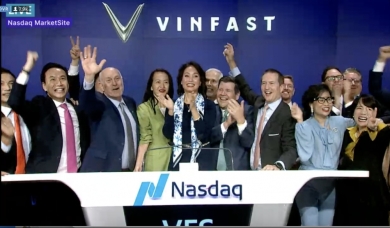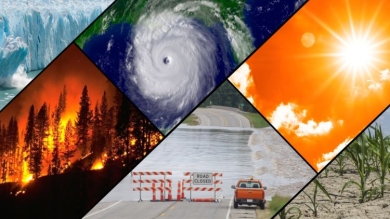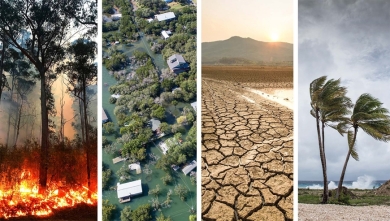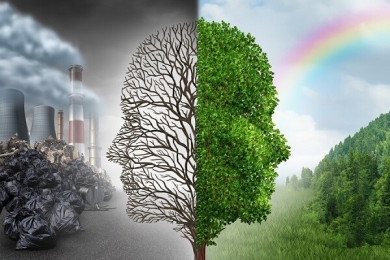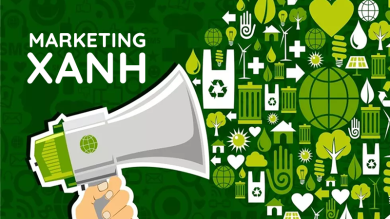The only path forward for tackling the climate crisis hinges on cooperative industrial strategies to coordinate clean energy investment and infrastructure development.

Even as President Trump bulldozes U.S. climate policy, the global clean energy transition is making remarkable strides: Investment in clean energy is now double the investment in fossil fuels; countries such as Türkiye and Pakistan are deploying solar at incredible rates; and the Gulf states, whose prosperity is tied to the success of oil and gas, are diversifying their economic bases and asset portfolios. In China, oil demand most likely peaked in 2021 and is now declining.
These promising developments weren’t born just out of concern for the well-being of the planet, nor did they emerge solely in response to climate science projections or global climate governance mandates. The rise of clean energy continues for a different reason: Clean technology drives down costs, creates economic opportunity and offers geopolitical freedom.
But to make the most of these forces, we need new approaches to global climate policy.
The Climate Geopolitics Era
Energy has always been at the center of state power. Long ago, human settlements gathered energy from the sun, predominantly in the form of biomass. Early states concentrated this energy as grain to build stores of economic, political and military power. Between the late 18th century and mid-19th century, the Industrial Revolution generated geopolitical power for the British Empire, but also created dependency on the coal supply chain, which had major choke points. The U.S. then led a global oil revolution on the back of wartime technological innovations, building a new financial and military hegemony. Power was concentrated in Western oil- and gas-producing countries. But the 1973 oil crisis exposed the risks of relying on foreign fuel, spurring investment in wind, solar, nuclear and geothermal.
Since then, science and advocacy awakened people to the threat of fossil-fuel-driven environmental catastrophe, creating a powerful global web of carbon accounting, decarbonization policy, diplomatic bargaining and technological advance. Yet it was naive to believe that this alone could transform a global energy system forged over centuries by war and empire.
Today, we have entered another historic epoch of change where geopolitics now drives climate action. The thermodynamic advantages of renewables and electric technologies are reconfiguring the global landscape of geopolitical power in three ways: through a competition to seize the economic opportunities in the energy transition, through a need for energy security and geopolitical autonomy in a more dangerous world, and through the effort to diversify economies to make them more resilient.
Green technologies such as solar panels, wind turbines and electric vehicles have major thermodynamic advantages over fossil fuels, the drilling, extraction, refining and transportation of which result in expensive energy losses at every distribution and conversion point. Sunlight and wind, on the other hand, produce power with little ongoing cost and are available nearly everywhere. And manufacturing these technologies is scalable and repeatable, which means that producers can learn and improve iteratively.
“It was naive to believe that science and advocacy alone could transform a global energy system forged over centuries by war and empire.”
Clean technologies aren’t just better for the environment — they’re increasingly more affordable and accessible in the long run, giving more countries a chance to achieve energy security and geopolitical autonomy. That is what’s driving clean energy’s adoption around the world, even in nations without strong climate agendas.
Global climate policy must adapt to this reality. The existing framework of legal and scientific imperatives, focused on precise emissions reduction targets, is not enough to sustain meaningful progress because it misses the true forces behind climate action today. Lasting change is more likely to come from strategies that directly confront international competition and try to channel it in productive directions.
The clean energy transition sparked an international competition to seize economic and geopolitical opportunities. China recognized this first and centered its geostrategic plans on new energy technology beginning in the 1990s. Now the competition is heating up; many governments are investing in green industrial policies to position their firms in global value chains.
The big Korean firms followed China into the solar and battery sectors later in the 2000s. The U.K. launched a wind industrial strategy in 2013. The European Battery Alliance was created in 2017 to reshore the battery supply chain and secure Europe’s industrial base. Indonesia launched a battery strategy in 2020. America was already well behind when it entered the global race with the climate-friendly Inflation Reduction Act in 2022. These policies have spurred the innovation and deployment necessary to advance the technologies for the future energy system.
Another geopolitical factor powering climate action is the push for energy security and autonomy. In the wake of Russia’s invasion of Ukraine, European nations realized the risks of relying on potential adversaries for critical energy supplies. Meanwhile, tension between China and the U.S. quickly spilled over into concerns about interdependency. As China worked to reduce its reliance on Western semiconductors, the U.S. worried about China’s control over supply chains for solar panels, battery components and critical minerals. China is now restricting the free flow of rare earths and other critical minerals, threatening to halt global automotive and aerospace assembly lines.
The risks of fossil fuel dependency were laid bare for Pakistan in 2022. As Europeans sought to get off Russian gas, they outbid Pakistan for liquified natural gas (LNG) contracts. The diverted gas triggered shortages and left Pakistan in a difficult position, which motivated investments in clean energy. Today, Pakistan has an LNG glut because it has rapidly deployed Chinese solar panels.
“Lasting progress to tackle the climate crisis is most likely to come from strategies that directly confront international competition and try to channel it in productive directions.”
Similarly, Ethiopia banned foreign imports of vehicles with internal combustion engines last year. China supported the deal by setting up an electric vehicle assembly there. As a result, Ethiopia’s economy is decarbonizing: Imports of oil and gas products have been flat since 2019, while the economy grew 70%.
When countries like Pakistan and Ethiopia install renewables, they get a win-win: They avoid high-cost fossil fuels and conserve scarce foreign dollars.
States that had previously depended on fossil fuel exports are seeking to diversify their economies to make them more resilient. China’s electric vehicle boom is already reducing oil demand, and its next green industrial policy frontiers — trucking, shipping and aviation — will likely decrease it further. Recognizing an existential threat, the Gulf states are betting that they can use their capital to replicate their position in a new energy order and generate the free cash flow and geopolitical leverage they once got from fossil fuels. The UAE, for example, has invested in renewables in Pakistan, Indonesia, Egypt, Senegal, South Africa, Uzbekistan and elsewhere. Abu Dhabi and Saudi Arabia have taken stakes in critical minerals projects.
This reflects the fact that the long-term outlook for oil demand may not be as good as the Organization of Petroleum Exporting Countries (OPEC) maintains. OPEC’s own 2022 projections showed that oil demand would rise only 10%, peaking in 2035 before flattening out. OPEC later revised this estimate upward, saying there’s no peak in sight. But, as the International Energy Agency analysis shows, demand growth in 2024 was low.
In this era of climate geopolitics, we must ensure that other sectors of the global economy reach a point at which clean alternatives are about as cheap and convenient as incumbent technologies. We must also scale clean energy supply chains so that even as these technologies go mainstream, costs and geopolitical risks remain manageable. To make this happen, a coalition of countries must advance a new approach to climate cooperation that channels geopolitics into investment and technology coordination — a challenge that is complicated by America’s backsliding under Trump.
There are three opportunities to achieve this: reorienting the United Nations Framework Convention on Climate Change (UNFCCC) to align with geopolitical realities, organizing strategic green investment to build developing economies, and creating plurilateral climate clubs.
Reorienting The UNFCCC
The UNFCCC was established in 1992 as the central multilateral negotiating forum for global climate policy. While the dream that it would help create a binding legal framework for global emissions reductions never materialized, it has served an essential scientific, political and moral role. The 1997 Kyoto Protocol and the 2015 Paris Agreement established the basic obligations and objectives of global climate action.
But the UNFCCC’s technical and legalistic procedures now seem out of date in a world where geopolitical competition and energy security drive climate action. To remain relevant, the convention must adapt with a new framework that places the structural transformation of economies via industrial policy at its center.
The UNFCCC’s current system asks countries to submit technical plans showing how they will cut greenhouse gas emissions. This foregrounds restrictive, incrementalist policy initiatives with limited impact. It also neglects the reality that decarbonization is fundamentally about achieving the structural transformation of energy systems in a competitive geopolitical landscape.
Instead, the UNFCCC should ask countries to show how they plan to make strategic investments as part of broader national plans for green development. This would mean identifying the economic opportunities arising from the clean energy transition and proposing ambitious investments to realize those plans. If a country aims to accelerate the clean energy transition, we now know that it needs to create a plan to invest in structural transformations that reward domestic firms. Innovative modeling techniques now allow these investments to be translated into emissions reductions, which wasn’t possible 30 years ago when the UNFCCC was created, or even 10 years ago when the Paris Agreement was struck.
This approach would ground the UNFCCC in the transformation of energy systems instead of the relatively abstract task of reducing emissions. It would not abandon emissions reduction goals, but rather embed them within a new political and economic frame for global climate action. If the UNFCCC fails to meet the moment and climate action proceeds according to geopolitics alone, we will lose this crucial moral, legal and scientific lever for global climate governance.
Organizing Strategic Green Investment
Sustaining meaningful climate action will require the mobilization of massive amounts of capital, especially in the developing world. To achieve this, we need a global vehicle for strategic investment in clean energy supply chains and manufacturing around the globe.
The world will not decarbonize at the pace necessary unless developing countries such as Indonesia, Brazil, Mexico, South Africa, Egypt and Nigeria feel that climate action secures their economic futures. Any truly global climate agenda is going to be contingent on strategic finance. The international system is full of funding vehicles, but most are not focused on supporting green industrial policy. We need a new institution, mechanism or program to bring together countries in the Global North and the Global South to identify areas where we can collaborate to build clean energy supply chains.
After the Second World War, it was primarily the American hegemon that led the construction of global public goods like the World Bank. But in this era, a critical mass of smaller countries will need to take on a collective leadership role. The EU, Japan, Korea, Canada and Australia will need to step up. Without U.S. leadership, these are the countries with the collective capital and policy influence to catalyze the development of global clean energy supply chains that benefit all.
Strategic investment in the Global South will also position these countries to secure the materials they need for their domestic manufacturing efforts while reducing their dependence on China and the U.S. The EU has already been experimenting with a global investment strategy through the Global Gateway and the Critical Raw Materials Act. These vehicles deploy strategic finance to deliver on the EU’s industrial strategy while creating economic opportunities in the receiving jurisdictions. The lessons learned from these vehicles could help inform a more ambitious program of co-investment.
“The thermodynamic advantages of renewables and electric technologies are reconfiguring the global landscape of geopolitical power.”
A new strategic investment body must start with clear targets that identify priority supply chain segments. Then it will need to create a prioritized pipeline of joint international clean energy projects and mobilize the finance necessary to complete them on the right timescales. But members must go beyond investment to support the innovation policy and market formation necessary to build and scale new technologies, critical minerals and clean energy infrastructure.
This is the developing field of joint industrial policy in which countries work together to coordinate strategic investment and infrastructure development at the international level. Industrial policy is already recognized as central to advancing domestic climate solutions by providing supply-push policies, which boost the supply of innovative and cost-effective technologies, and demand-pull policies, which create secure markets for new products to ensure those technologies scale and become price-competitive.
On the supply side, countries should work together to build clean energy technology more effectively. This will mean sharing expertise on industrial policy design, coordinating research and development efforts, and aligning subsidy programs so they reinforce rather than undermine each other.
On the demand side, governments need to create reliable markets for clean technologies. They can do this by aligning public procurement, standardizing regulations across countries, offering pricing guarantees to make projects viable and using trade policies to level the playing field for domestic clean industries.
Creating Climate Clubs
Because strategic investment is needed to advance technologies and scale clean energy supply chains, countries need to address the specific problems that will arise in the sectors with highly calibrated policy mixes. This detailed work is hard to pull off in universal, multilateral forums like the UNFCCC, where every member has veto power. Instead, plurilateral climate clubs can build close cooperation at the sectoral level. This would enable small groups of states with shared decarbonization and industrial policy objectives to work together to integrate supply-push and demand-pull policies to secure markets in opportune areas like steel, critical minerals or rare earth magnets.
Climate clubs offer “club goods”: benefits for members who follow the rules, such as harmonized tariffs and subsidies, and who fulfill their obligations, such as contributing to pooled investment funds. The goal is to create a secure, self-sustaining market, driving deployment and causing costs to fall, like we’ve seen with renewables, electric vehicles and heat pumps. In 2023, a group of 45 countries launched a climate club to advance steel and cement decarbonization. The club is just now setting to work, but it has advanced a set of common principles that provide the foundation for North-North and North-South cooperation in the crucial heavy industry sector.
Though there are some promising initiatives and bilateral partnerships with these goals, we need to go further with sector-specific clubs for aviation, fertilizer, critical minerals and other areas where serious work is required to find and develop the potential thermodynamic advantages of net-zero alternatives. Critically, these clubs will need to bring together advanced and developing countries to forge collaborative supply chains for these emerging technologies. This could provide nations in the Global South with real opportunities to capture value, but must not be executed in an extractive fashion to transfer raw commodities from poor to rich countries to be processed into high-value materials.
A Green Spiral
Together, these three actions could bring global climate institutions into line with the emergence of domestic industrial strategy as a critical climate solution. Adapting governance strategies to foster competition and cooperation between countries could lead to a “green spiral” through which technological and policy innovations create self-sustaining processes of decarbonization.
If competition between states can drive down the costs of net-zero steel or cement, these industries could follow the trajectories of renewables, electric vehicles, heat pumps and industrial heat, with firms and households adopting them simply because they make economic sense. Economic success would help to forge the political coalitions of policymakers, firms and citizens necessary to support deep decarbonization.
Of course, green industrial policy could fall short. It operates according to its own economic logic, independent from emissions reduction frameworks, and not all domains of climate solutions are domains of thermodynamic advantage. But the only path forward is to double down on what has worked to get climate technology and policy to this point: focused industrial strategies to bolster technology and clean energy supply chains.
By Bentley Allan - NoemaMag


